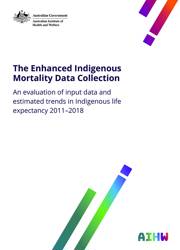Summary
Progress against the target to close the gap in life expectancy within a generation, by 2031, is measured using estimates produced by the Australian Bureau of Statistics (ABS). The Enhanced Indigenous Mortality Data Collection (EIMDC), and its predecessor, the Enhanced Mortality Database (EMD) were created by the AIHW to assess the feasibility of providing more frequent estimates of Indigenous life expectancy at both the national and sub-national levels to support the “Closing the Gap” reporting.
The EIMDC contains information on enhanced Indigenous identification, fact of death, cause of death and demographic information for all registered deaths that occurred in Australia between 1 January 2011 and 31 December 2018.
This report presents results using the EIMDC to estimate the levels, age‑sex patterns and trends in Indigenous and non-Indigenous mortality and life expectancy, as well as the gap between Indigenous and non-Indigenous mortality and life expectancy, over the period 2011–2018. The report also presents estimates of the relative contribution of different age groups and causes of death to the gap in life expectancy between Indigenous and non-Indigenous Australians.
The Indigenous and non-Indigenous mortality and life expectancy estimates were calculated using the EIMDC and a cohort-interpolated denominator population calculated from Australian Bureau of Statistics (ABS) back-cast and projected Indigenous population based on the 2011 and 2016 censuses of Population and Housing, and the Indigenous estimated resident population from the 2021 Census of Population and Housing.
A number of mortality measures and indicators – namely, age-specific death rates, the cumulative proportions of deaths occurring by specified ages, and age-standardised death rates – have shown that mortality has declined, albeit slightly, in most age groups for both Indigenous males and females across the 6 jurisdictions considered. There were also similar declines in mortality for non-Indigenous males and females.
The analysis shows that in 2016–2018, Indigenous life expectancy was estimated to be about 72 years for males and about 77 years for females. About 50% of Indigenous males now survive to age 74–77, while 50% of Indigenous females now survive to age 77–82. There are wide variations in the estimates of Indigenous life expectancy between states and territories.
During the reference period 2011–2013 to 2016–2018, estimated life expectancy at birth increased by about 0.6 years for both Indigenous males and females. At the same time, estimated life expectancy at birth increased by about 0.7 years for non-Indigenous males and by about 0.5 years for non-Indigenous females.
Within age groups, mortality among Indigenous males aged 45–64 and among Indigenous females aged 65 and over contributed the most to the gap in estimated life expectancy between Indigenous and non-Indigenous Australians. Within causes of death, deaths from circulatory diseases, injuries and neoplasms were the main contributors to the gap in life expectancy between Indigenous and non-Indigenous males and between Indigenous and non-Indigenous females.
While the EIMDC has produced promising results, estimation of Indigenous life expectancy involves many challenges, including random variation in death counts, inconsistency in Indigenous identification between the death data and the denominator population, the absence of a dedicated, ongoing and reliable population-at-risk to underpin the mortality and life expectancy estimates as well as differences between jurisdictions in the protocols and processes for identifying and recording Indigenous identification on death data. These challenges make estimation of life expectancy challenging in some jurisdictions and contribute to uncertainty about time trends and comparisons between jurisdictions.
The AIHW is investigating and consulting on measures to address these problems, including the possibility of using linked datasets to define the population at risk in a way that is consistent with the deaths data. Future AIHW publications will describe these methods in more detail and evaluate their performance.
Summary
- What this report is about
- Structure of the report
- History and structure of the EIMDC
- Aims and objectives of the EIMDC
- Data sets and mehods used to create the EIMDC
- Population denominators
- Future work
- Data evaluation, sensitivity tests and choice of methods
- Biases due to unlinked data
- Consintency of indigenous identification between data sets
- Choice of algorithm
- Reported and enhanced number of deaths
- Sensitivity of life expectancy estimates to potential errors in algorithms
- Choice of denominator population
- Evaluation of algorithms
- Mortality levels, patterns and trends
- Introduction
- Summary measures of mortality
- Age pattern of mortality
- Age-standardised death rates
- Conclusion
- Life expectancy
- Key data inputs
- Survival from birth to specified ages
- Indigenous life expectancy (2011–2018)
- Age decomposition of the gap in life expectancy
- Probability of survival
- Conclusion
- Preliminary estimates of life expectancy at birth, 2019–2021
- Conclusion
- Discussion
- The way forward
- Conclusion
- Appendix A: Source of data
- A1 Enhancement of Indigenous identification on death records on the National Death Index
- A1.1 Background
- A1.2 Data sets
Endmatter: Acknowledgements; Abbreviations; Symbols; Glossary.



